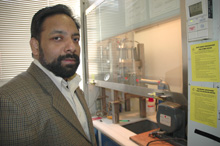$1.5-million project builds optical micro instruments

Muthukumaran Packirisamy
Photo by Armen Tamzarian
Big things are happening at Concordia, but you may need a microscope to truly appreciate the depth of what Muthu-kumaran Packirisamy and co-inventor Ashok Balakrishnan are piecing together in the lab.
Concordia continues to build on its long tradition in MEMS (micro-electro-mechanical systems) by pushing the limits once again in a breakthrough project that will lead to the commercialization of Packirisamy’s invention in the area of optical MEMS.
Thirty agreements and a lot of hard work by Concordia’s Office of Research and its commercialization partner Gestion Valeo were needed to bring this project to life.
The total value of the project is estimated at $1.5 million, a third of which will go to Concordia via a grant supported by Valorisation Recherche Quebec and obtained by Valeo. Packirisamy, as principal investigator, and Ion Stiharu, as co-investigator, will manage the grant.
The $1 million balance is an investment on the part of Enablence, one of two industrial companies that have joined in the partnership. This investment will be used solely by Enablence to support the development of their portion of the technology platform.
“Nothing like this has ever happened in the history of Concordia,” Packirisamy said in an interview. “Thirty agreements have been signed for a project in such a short amount of time. This is very rare.”
His invention will expand on the concept of MEMS by adding optical and biological elements to its existing mechanical and electronic ones.
“We want to achieve a fully integrated optical MEMS environment,” he said. “The advantage with packing so many elements into one microchip is that you can make it more robust, cheaper and you can get closer to the physics, increasing accessibility to the real problem.”
One of the key advantages of a fully integrated platform is that it has can be used for many different things. Packirisamy believes the potential of this product is huge.
“Miniaturization is the key now, and it’s found everywhere, from cell phones to medical devices,” he said. “The medical field is one that can take full advantage of this because you can make things like disposable blood test instruments that you can use yourself. It’s cheap, and you don’t have to go to the hospital. It’ll come to you.”
After recognizing the commercial potential of this invention, Packirisamy and his colleagues put a patent on it and approached Concordia with their idea. The commercial prospects of the invention were assessed and recognized by Valeo Management, who then began networking for potential partners.
“Dr. Packirisamy’s achievement is certainly a milestone for Concordia,” said Shelley Sitahal, manager of the Industry and Partnership unit at Concordia’s Office of Research.
“The ability to attract external investments of this magnitude is a testament to the commercial viability and innovativeness of his technology. This funding strengthens considerably Dr. Packir-isamy’s already well-recognized MEMS research program, allowing him to continue to be on the cutting edge of this field.”
The project should reach completion in a year and a half, but Packirisamy has been working on his invention for over three years. He has already done the theoretical work for the project and established its feasibility.
His next steps are finding suitable fabrication methods, designing a system and doing further testing before actually developing a product. He will be doing all this in addition to the four courses he teaches in the Department of Mechanical Engineering.
“This invention has been on my mind for a long time. It’s a great feeling.”